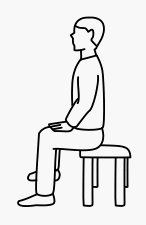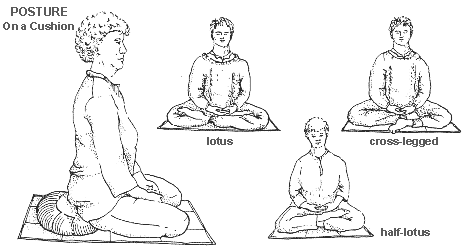Meditation requires that we are first in the right state of mind and body. If we are "stressed out" we should first do something that will relax us, like exercise, gardening, cooking, taking a shower: whatever works for us. When we begin, we should also not be tired, or have eaten recently. If we are awake and our bodies are not working hard to digest food, we will have greater success with the practice.
STEP 1

The first thing we want to do is sit in such a way that our backs are reasonably straight and our shoulders relaxed. For people who have been meditating for a long time, the half-lotus or full lotus positions are usually used because these positions allow the body to have three points of contact, like a tripod, which gives us lots of stability, allowing us to easily stay in the position for a long period of time without fatigue. But when we are learning we don't want to jump into this because the process of getting comfortable with these positions can be painful, which can hinder us from the objective--to learn to meditate.
Most people find it comfortable to sit on a chair, either with a hard seat, or a thin cushion, sitting on the front half to two-thirds. This prevents us from leaning back. The legs need to be positioned so that they are not putting any force on the body, pushing it backward or forward. Some experimentation is needed here -- it may be necessary to cross the calves depending on how long the legs are, and how high the chair is. The objective is to put the torso in as much of a straight vertical position as possible. Imagine a thin fishing line along your spine, rising through the top of your head and being pulled taught. This will help align the head, and therefore the top of the spine. Sitting in front of a mirror can be helpful. Sometimes we think we're sitting perfectly, but when we see ourselves we realize we need to make some adjustments. Once we are in a good position we should feel nicely balanced, not needing to lean one way or another. Imagine being like the trunk of a strong old oak tree, immovable, rooted to the seat which is rooted to the floor and to the earth.
The next thing is to take your attention and put it on the breath. At first just watch your breath. Don't try to control it. What is it doing? Is it shallow or deep? Is it regular and even, or irregular? Most of us use a very small part of the lungs when we breathe, unless we are exercising and our body is craving oxygen. Vigurous Exercise forces us to breathe deeply and fully and rhythmically. But we can learn to breathe deeply and regularly while we're sitting too, and this is training that goes a long way in preparing us for meditation. Some people have slipped into meditation after only a very few times of practicing this.  So, as you are sitting and balanced and grounded, exhale naturally until it's no longer comfortable to do so; then slowly inhale, also until it becomes uncomfortable to inhale further. Continue doing this, taking slow, deep breaths. With some experimentation you will soon be able to establish a rhythm, and will be breathing in and exhaling out more deeply and rhythmically than you normally would. Focus all your attention on this and do it for as long as you can. Some people find that five minutes at a time is good, others like going for ten or fifteen minutes. It’s better to use short periods where you are focusing intently on the practice than to go longer and lose your concentration. I have found people have most success if they practice for five minutes, then take a break, then practice for another 5 minutes, and repeat this cycle three or four times every day.
So, as you are sitting and balanced and grounded, exhale naturally until it's no longer comfortable to do so; then slowly inhale, also until it becomes uncomfortable to inhale further. Continue doing this, taking slow, deep breaths. With some experimentation you will soon be able to establish a rhythm, and will be breathing in and exhaling out more deeply and rhythmically than you normally would. Focus all your attention on this and do it for as long as you can. Some people find that five minutes at a time is good, others like going for ten or fifteen minutes. It’s better to use short periods where you are focusing intently on the practice than to go longer and lose your concentration. I have found people have most success if they practice for five minutes, then take a break, then practice for another 5 minutes, and repeat this cycle three or four times every day.
Initially, learning this exercise while sitting is best, because it allows us to really focus on it with few distractions. But once we’ve mastered it, we can practice it while walking as well. When we’re doing our daily routines it’s extremely difficult to maintain regular deep breathing, but it’s interesting to try to become aware of our breathing when we’re doing other things. Over time this practice will automatically change the way we breathe all the time. It will also help reduce our stress and anxiety and improve our overall sense of well-being.
STEP 2

Once we have firmly established the ability to be mindful of our breath and to consciously modify the rhythm and depth of our breathing we have taken the first step toward meditation. It is important not to move on to this exercise until this first step was mastered. When I first started to learn to meditate over 30 years ago, I was unable to sit for more than two minutes. Being alone with my mind was torture. In fact, after that one experience I could not bring myself to try it again for another 5 years! Being psychologically, mentally, and physically ready for each successive practice is essential for success, and trying to jump ahead before we are ready will sabotage our efforts.
When we focus our mind on something, that “something” is called a seed. A seed starts as something very small, but as we water it, it sprouts and turns into something entirely different from the seed it was born from.
Focusing on the breath, the seed, the mind becomes aware of the seed. This was the first step. The second step is to bring the seed to sprout, and for this we will continue working with the breath, using a Pranayama exercise called the Healing Breath. The term Pranayama comes from Sanskrit meaning extension of the breath. So we are going to take our seed and extend it until it sprouts.
The Healing Breath is performed in three parts in a carefully regulated pattern, or ratio, in a "1:4:2" sequence: an inhale (1-count), a hold (4-counts), and an exhale (2-counts). This means that the breath is held for four times the amount of time taken to perform the inhale, and the exhale is completed in twice the time taken to inhale. When we first start the practice, we begin with a ratio sequence of 4:16:8, where each count is approximately one second. Then, as the breath becomes stronger and more durable, we may move to a ratio sequence of 6:24:12, and then 8:32:16, etc. As you work with the Healing Breath, gradually extend the number of counts for longer and longer durations, maintaining the same ratio and one-second count interval. If you are a smoker you will have a harder time with larger ratio sequences, but don’t let that deter you from mastering a shorter sequence.
An audible clock can be used to "click-off" the time in one-second intervals, or, if the heartbeat can be felt or heard, it can be used instead. When doing the practice, continuous focused concentration on the count is essential. Within days or weeks, subtle changes in mood and physical energy will become apparent.
Practice this exercise until you are able to repeat a sequence continuously for fifteen minutes or more.
STEP 3
After steps 1 and 2 have been mastered you should be able to sit and focus the mind with good concentration for at least 15 minutes. From here, there are many different directions of training that can be taken, however the essential aim at this point is to become “rooted”, to integrate the mind and the body until there is no separation felt between the two.
After completing 15 minutes of the Healing Breath, discontinue that exercise but continue to watch the breath. Instead of trying to control the breath, let it happen naturally and be aware of it in its entirety. You should find breathing to be deep and regular and comfortable. Feel the air flow into nose and into the lungs on an inhale, and feel your lungs expanding. On the exhale feel the air leave as it came in, the diaphragm relaxing. Continue this watchful breathing for 5 to 10 minutes, then get up and take a break, walk or stretch.
During this phase it is possible to slip into meditation: it depends on how intensely focused and concentrated you have been with the exercises. It can take anywhere from weeks to months to train the mind to concentrate. The harder we work at it, the faster it happens. Once we slip into meditation we will know it, for there’s nothing else like it. The first time it happens it may startle us so much that we come out it quickly. Staying in meditation takes, like everything else, practice and time, but the more we do it, the more it happens quickly and easily. Experienced meditators can enter meditation within the first few minutes of sitting. The mind simply knows where to go.
While these instructions are simple, the task of learning to focus the mind can be long and arduous. As we go through life having experience after experience, the mind becomes chaotic. We sometimes call it “monkey mind”. Unable to think clearly, our emotions take over, influencing our decisions and actions, pulling us and pushing us in all directions. This way of being becomes ingrained in us to the point that we identify ourselves with it. “This is who I am,” we say to ourselves. Breaking out of such a strong binding condition can be a tremendous challenge. Fear can play a role, as severing our self-identity can feel like self-annihilation. We know what we want to break away from, but not where we will be, or where we will go, when the job is done. But with all this said, the approach to meditation I have outlined does work as long as we stay with it and ride the highs and lows and not give up.
Some of the effects of learning to meditate.
At the beginning, as we are learning to focus the mind, our emotions may become inflated – we may feel anxious, easily irritated, and may experience insomnia. I explain this with the model developed by Carl Jung, as repressed emotional content making itself conscious. If we have had a harsh childhood, we may have extreme reactions during the early stages of learning to meditate. But as we continue, there is a tremendous sense of relief as we go through the purging process. All the repressed emotions we’ve been carrying around with us have been influencing us without our even noticing. As they bubble up and we let them go, we take progressive steps toward individuation, toward wholeness of being. If this happens to you, take a break from the meditation practice for a few days or weeks to let your psyche process the changes. The process should not be rushed.
As the mind becomes more and more able to concentrate we will start to notice some other changes in our life. We will notice that we are more aware of things around us … from sounds to things sitting on shelves that we hadn’t taken notice of before, to the subtle tastes and textures of foods. We will be more aware of our speech, using words more selectively, able to convey our thoughts more accurately and easily. We will have increased energy and a general improved sense of well-being.
